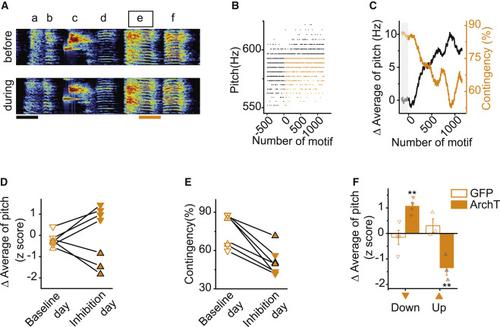Our official English website, www.x-mol.net, welcomes your
feedback! (Note: you will need to create a separate account there.)
A Basal Ganglia Circuit Sufficient to Guide Birdsong Learning.
Neuron ( IF 14.7 ) Pub Date : 2018-Apr-04 , DOI: 10.1016/j.neuron.2018.02.020 Lei Xiao , Gaurav Chattree , Francisco Garcia Oscos , Mou Cao , Matthew J. Wanat , Todd F. Roberts
Neuron ( IF 14.7 ) Pub Date : 2018-Apr-04 , DOI: 10.1016/j.neuron.2018.02.020 Lei Xiao , Gaurav Chattree , Francisco Garcia Oscos , Mou Cao , Matthew J. Wanat , Todd F. Roberts

|
Learning vocal behaviors, like speech and birdsong, is thought to rely on continued performance evaluation. Whether candidate performance evaluation circuits in the brain are sufficient to guide vocal learning is not known. Here, we test the sufficiency of VTA projections to the vocal basal ganglia in singing zebra finches, a songbird species that learns to produce a complex and stereotyped multi-syllabic courtship song during development. We optogenetically manipulate VTA axon terminals in singing birds contingent on how the pitch of an individual song syllable is naturally performed. We find that optical inhibition and excitation of VTA terminals are each sufficient to reliably guide learned changes in song. Inhibition and excitation have opponent effects on future performances of targeted song syllables, consistent with positive and negative reinforcement of performance outcomes. These findings define a central role for reinforcement mechanisms in learning vocalizations and demonstrate minimal circuit elements for learning vocal behaviors. VIDEO ABSTRACT.
中文翻译:

足以指导Birdsong学习的基底神经节回路。
学习语音行为,例如语音和鸟鸣,被认为依赖于持续的绩效评估。尚不清楚大脑中的候选性能评估电路是否足以指导声音学习。在这里,我们测试了唱歌斑马雀的VTA投影到声带基底神经节的充分性,斑马雀是一种鸣禽,在开发过程中学会制作复杂且定型的多音节求爱歌曲。我们视鸟类操纵VTA轴突末端为条件,这取决于自然如何执行单个歌曲音节的音高。我们发现,对VTA终端的光抑制和激励都足以可靠地指导所学歌曲的变化。抑制和激励会对目标歌曲音节的未来表现产生不利影响,与绩效结果的正面和负面增强相一致。这些发现定义了强化机制在学习发声中的核心作用,并展示了用于学习发声行为的最小电路元件。视频摘要。
更新日期:2018-03-16
中文翻译:

足以指导Birdsong学习的基底神经节回路。
学习语音行为,例如语音和鸟鸣,被认为依赖于持续的绩效评估。尚不清楚大脑中的候选性能评估电路是否足以指导声音学习。在这里,我们测试了唱歌斑马雀的VTA投影到声带基底神经节的充分性,斑马雀是一种鸣禽,在开发过程中学会制作复杂且定型的多音节求爱歌曲。我们视鸟类操纵VTA轴突末端为条件,这取决于自然如何执行单个歌曲音节的音高。我们发现,对VTA终端的光抑制和激励都足以可靠地指导所学歌曲的变化。抑制和激励会对目标歌曲音节的未来表现产生不利影响,与绩效结果的正面和负面增强相一致。这些发现定义了强化机制在学习发声中的核心作用,并展示了用于学习发声行为的最小电路元件。视频摘要。











































 京公网安备 11010802027423号
京公网安备 11010802027423号